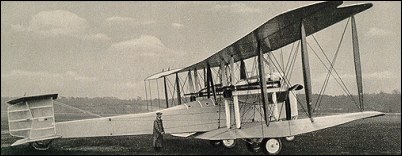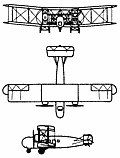 |
Vickers F.B.27 Vimy1917 |  |
| HEAVY BOMBER | Virtual Aircraft Museum / United Kingdom / Vickers |
 |
Design of the Vickers F.B.27 was initiated in 1917 to meet the requirement to provide bomber aircraft able to attack strategic targets in Germany from bases in Britain. Such aircraft as the de Havilland D.H.10 Amiens and Handley Page V/1500 were also built. The de Havilland and Vickers designs were of similar size, but the Handley Page V/1500 was almost twice as large. The F.B.27 was a three-bay biplane of then-conventional construction, with a biplane tail unit which had twin fins and rudders. The wing centre-section - almost one-third span - had the fuselage at its centre with large struts supporting the upper wing. At the outer ends of this centre-section the engines were mounted midway between the upper and lower wings. Two twin-wheel main landing-gear units were mounted beneath the lower wing, one directly below each engine. Outboard of this centre-section the wings had dihedral. The largest aircraft then built by Vickers, it posed many construction problems; but despite this the first prototype flew on 30 November 1917 - little more than four months after the design had been started. This aircraft was powered by two 149kW Hispano-Suiza engines (subsequently re-engined with 194kW Salmsons). Three further prototypes followed, powered respectively with 194kW Sunbeam Maoris, 223kW Fiat A-12s and 268kW Rolls-Royce Eagle VIIIs. It was the latter installation which was selected for production aircraft. With the introduction of official aircraft names in 1918, the F.B.27 became the Vimy. But only a single example had been placed on an operational footing before the Armistice, which meant that none were used operationally in World War I. However a total of 99 was built for service with the RAF post-war, remaining in first-line service until replaced by Virginias in 1924-25. The veteran bomber was then revived as an advanced instructional aircraft for training pilots in multi-engined flying. For this purpose Jupiter VI or Jaguar engines were fitted. The Vimy is remembered especially in aviation history for the post-war long-distance flights which pointed the way to the air lanes that would link the world. First was the flight by Capt John Alcock and Lt Arthur Whitten-Brown across the North Atlantic, from St John's, Newfoundland, to Clifden, Eire, during 14-15 June 1919 in a time of 16 hours 27 minutes. Next was the England-Australia flight of the brothers Capt Ross and Lt Keith Smith, together with Sgts Bennett and Shiers. Taking off from Hounslow (not far from today's Heathrow Airport) on 12 November 1919, they landed safely at Darwin on 10 December 1919 in an elapsed flying time of 135 hours 55 minutes. Last of the trio of great Vimy flights was an attempt by Lt-Col Pierre van Ryneveld and Sqn Ldr Christopher J. Q. Brand of the South African Air Force to link London and Cape Town. On 4 February 1920 they took off from Brooklands, unfortunately making a crash landing between Cairo and Khartoum. Loaned a second Vimy by an RAF unit in Egypt, they continued to Bulawayo, Southern Rhodesia, where they failed to get airborne because of 'hot and high' conditions. They finally completed their flight to Cape Town in a third borrowed aircraft (a de Havilland D.H.9), arriving at their destination on 20 March 1920. They, like Alcock and Brown and the Ross brothers, were awarded knighthoods for their achievement. In addition to the Vimy bomber, a small number of commercial and ambulance aircraft were built, known simply as Commercial Vimys.
|  COMPANY PROFILE | ||||||||||||||||||||||||||||||||||||||||||||||||||||||||||||
 |

|

